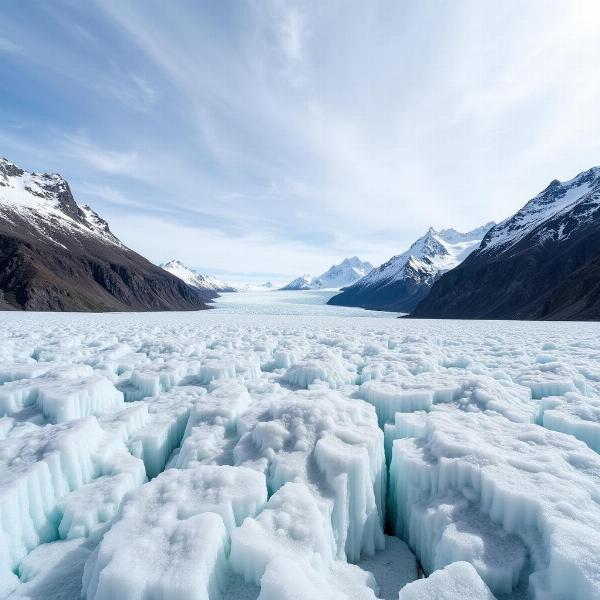Firn, a crucial element in glaciology, often leaves people wondering about its Hindi equivalent and deeper meaning. This article explores the “firn meaning in hindi,” delving into its significance in various contexts. We’ll cover its formation, characteristics, and relevance to glacial studies, providing a comprehensive understanding of this fascinating natural phenomenon.
What is Firn and Its Hindi Equivalent?
Firn, essentially dense granular snow, represents a transitional stage between snow and glacial ice. While there isn’t a single, perfect Hindi word for “firn,” terms like “पिंडित हिम” (pindit him) or “सघन हिम” (saghan him) effectively capture its essence, emphasizing the compacted nature of this unique form of snow. These terms highlight the density and granular structure, crucial for understanding firn’s role in glacier formation. It’s more than just snow; it’s a step towards becoming ice.
The Formation of Firn: A Step-by-Step Process
Firn formation begins with the accumulation of snow over time. As new layers of snow deposit, the underlying layers experience increased pressure. This compaction process forces the snow crystals to recrystallize, forming larger, rounded grains. The air pockets between the snow grains gradually reduce, increasing the density of the snowpack. Over several years, this compacted snow transforms into firn.
Factors Influencing Firn Formation
Several factors influence the rate of firn formation, including temperature, snowfall, and wind patterns. In colder regions with consistent snowfall, firnification progresses more rapidly. Conversely, warmer temperatures can lead to meltwater percolation, hindering the densification process.
 Firn in a Glacial Environment
Firn in a Glacial Environment
The Significance of Firn in Glaciology
Firn plays a critical role in glacier mass balance and dynamics. It acts as a reservoir of water, slowly releasing meltwater that contributes to glacial runoff. Furthermore, firn properties influence glacier flow and response to climate change.
Firn and Climate Change Studies
Scientists study firn to understand past climate conditions and predict future glacier behavior. Analyzing firn cores provides valuable insights into historical temperature and precipitation patterns. This information helps researchers model the impact of climate change on glaciers and the subsequent effects on sea level rise and water resources.
Firn vs. Snow and Ice: Key Differences
While related, firn differs significantly from both snow and ice. Snow, the initial stage, consists of loosely packed ice crystals. Firn, the intermediate stage, exhibits a denser, granular structure. Finally, glacial ice, the final stage, is a solid, interlocking mass of ice crystals.
Conclusion: Firn’s Importance in the Cryosphere
Understanding “firn meaning in hindi” and its broader significance sheds light on the complex processes shaping our planet’s cryosphere. From its formation process to its role in glacial dynamics and climate change studies, firn is a crucial element worthy of further exploration. Its study provides valuable insights into the delicate balance of our planet’s frozen realms.
FAQ
- What is the exact Hindi translation of “firn”? While no single word perfectly captures its meaning, “पिंडित हिम” (pindit him) or “सघन हिम” (saghan him) convey the essence of dense, granular snow.
- How long does it take for snow to become firn? The firnification process can take several years, depending on environmental factors.
- Why is firn important for glacier studies? Firn properties influence glacier flow and provide valuable information about past climate conditions.
- How does firn contribute to sea level rise? Firn, as part of glaciers, stores vast amounts of water. Melting firn contributes to glacial runoff, which ultimately impacts sea levels.
- What are the key differences between firn, snow, and ice? Snow is loosely packed ice crystals, firn is denser and granular, and glacial ice is a solid, interlocking mass.
- How do scientists study firn? Researchers analyze firn cores to understand past climate conditions and predict future glacier behavior.
- Where can I find more information about firn and glaciology? Various online resources and scientific publications offer detailed information on this topic.
Looking for Professional Hindi Translation Services?
Meaning-Hindi.in is your one-stop solution for high-quality Hindi translation services. We specialize in various fields, including business, legal, technical, website localization, educational, and specialized translation. Whether you need to translate business documents, legal contracts, or technical manuals, our expert team ensures accuracy, cultural sensitivity, and timely delivery. Contact us today for all your Hindi translation needs. Email: [email protected], Phone: +91 11-4502-7584. Meaning-Hindi.in is dedicated to bridging the language gap and facilitating seamless communication.